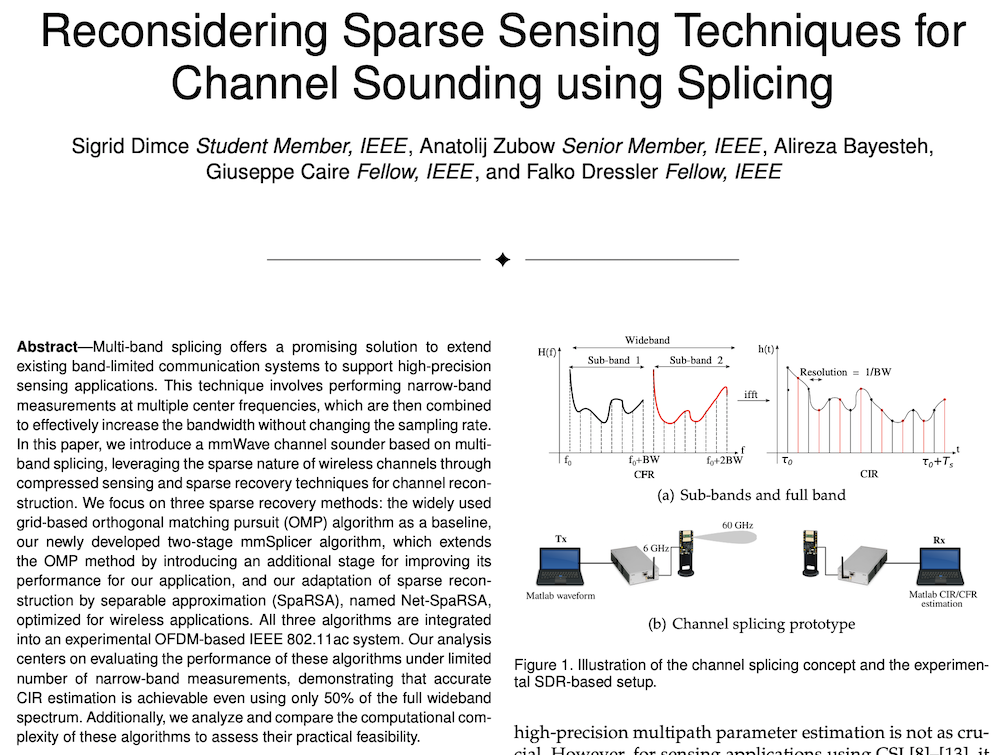Literature Database Entry
fronk2024implementation
Daniel Fronk, "Implementation of an Energy Efficient Coded Flooding Algorithm for Wireless Sensor Networks (WSNs) using ESP NOW," Master's Thesis, School of Electrical Engineering and Computer Science (EECS), TU Berlin (TUB), May 2024. (Advisor: Anatolij Zubow; Referees: Falko Dressler and Thomas Sikora)
Abstract
Nodes in Wireless Sensor Networks (WSNs) are typically powered by batteries with limited energy capacity. They are often spread across large geographical areas and are costly to maintain. As stated in [1], wireless transmissions are the most power-hungry components in a WSN. For this reason, energy efficiency and awareness in synchronization and routing protocols can have a huge impact on the lifetime and maintenance cost of a WSN. In [2], Cooperative Power and Energy-efficient Routing Protocol (COPE) is presented, which is an advanced routing algorithm with high throughput. COPE combines network coding together with broadcast communica- tions to increase throughput. In my thesis, I aim to implement an energy-efficient flooding architecture based on COPE [2] which distributes packets in an encoded manner to minimize transmissions and reduce energy consumption. The flooding algorithm is embedded into a globally synchronized duty cycle and deployed on the ESP32 platform together with the underlying ESP NOW protocol. In the beginning of my thesis, comparable research papers on energy-efficient synchronization and routing protocols are reviewed. Subsequently, I describe hardware and software components on which the proposed implementation is built. In the main part of my thesis, the general architecture and key implementation features are presented. In the end, the performance of the synchronization and flooding protocol is tested and evaluated. It is acknowledged that simple broadcast protocols may outperform my proposed energy-efficient flooding architecture in a single network scenario, in which each node is in radio range to each other. However, when comparing it to multi-hop scenarios, it can significantly decrease the number of transmissions and therefore increase energy efficiency.
Quick access
Contact
Daniel Fronk
BibTeX reference
@phdthesis{fronk2024implementation,
author = {Fronk, Daniel},
title = {{Implementation of an Energy Efficient Coded Flooding Algorithm for Wireless Sensor Networks (WSNs) using ESP NOW}},
advisor = {Zubow, Anatolij},
institution = {School of Electrical Engineering and Computer Science (EECS)},
location = {Berlin, Germany},
month = {5},
referee = {Dressler, Falko and Sikora, Thomas},
school = {TU Berlin (TUB)},
type = {Master's Thesis},
year = {2024},
}
Copyright notice
Links to final or draft versions of papers are presented here to ensure timely dissemination of scholarly and technical work. Copyright and all rights therein are retained by authors or by other copyright holders. All persons copying this information are expected to adhere to the terms and constraints invoked by each author's copyright. In most cases, these works may not be reposted or distributed for commercial purposes without the explicit permission of the copyright holder.
The following applies to all papers listed above that have IEEE copyrights: Personal use of this material is permitted. However, permission to reprint/republish this material for advertising or promotional purposes or for creating new collective works for resale or redistribution to servers or lists, or to reuse any copyrighted component of this work in other works must be obtained from the IEEE.
The following applies to all papers listed above that are in submission to IEEE conference/workshop proceedings or journals: This work has been submitted to the IEEE for possible publication. Copyright may be transferred without notice, after which this version may no longer be accessible.
The following applies to all papers listed above that have ACM copyrights: ACM COPYRIGHT NOTICE. Permission to make digital or hard copies of part or all of this work for personal or classroom use is granted without fee provided that copies are not made or distributed for profit or commercial advantage and that copies bear this notice and the full citation on the first page. Copyrights for components of this work owned by others than ACM must be honored. Abstracting with credit is permitted. To copy otherwise, to republish, to post on servers, or to redistribute to lists, requires prior specific permission and/or a fee. Request permissions from Publications Dept., ACM, Inc., fax +1 (212) 869-0481, or permissions@acm.org.
The following applies to all SpringerLink papers listed above that have Springer Science+Business Media copyrights: The original publication is available at www.springerlink.com.
This page was automatically generated using BibDB and bib2web.






